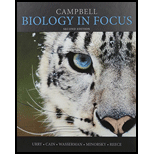
Concept explainers
To identify:
The lineages as plants, non vascular plants, vascular plants, seedless vascular plants and seed plants with reference to Figure 26.18 “Highlights of plant evolution” and also explain which of these categories are monophyletic and which are paraphyletic with reference to Figure 20.10 “Monophyletic, paraphyletic and polyphyletic groups’, in the textbook.
Introduction:
The evolution history of the organism is known as phylogeny and the branched diagram for evolutionary relationships among species based on their genetic and physical characteristics is known as phylogenetic tree which is also known as evolutionary tree.
Monophyletic groups are those which consist of ancestor and all of its descendents, paraphyletic group includes ancestor and few but not all descendents and polyphyletic group includes species that are distantly linked and does not include recent common ancestor.
Want to see the full answer?
Check out a sample textbook solution
Chapter 26 Solutions
Campbell Biology in Focus; Modified Mastering Biology with Pearson eText -- ValuePack Access Card -- for Campbell Biology in Focus (2nd Edition)
- Use the image to correctly fill in the following blanks. The whole specimen is a [A], a gametophyte structure found in the phylum [B]. The structures found within the circle are called, [C] and the arrows point at examples of [D]. [E] seen in the triangle are only to keep the plant anchored in place. ASUS VivoBookarrow_forwardMAKE CONNECTIONS In addition to cotyledon number, how do thestructures of monocots and eudicots differ? (See Figure 30.16.)arrow_forwardRefer to Figure 18. Are the storage roots of sweet potato ( Ipomoea batatas) and the tubers of potato ( Solanum tuberosum) analogous or homologous? Explain the answer brieflyarrow_forward
- Part 1: Identify the haploid and diploid generations of the following plants. (Examples are found in your prelab reading) Identify the Bryophyte and if it is in its haploid or diploid reproductive state. A hornwort Haploid B Moss Haploid C Liverwort Haploid List the stages of the life cycles for all three classes of Bryophytes starting from the spore stage. 中 Mosses Liverworts Hornworts Spore Spore Spore How does the life cycle of nonvascular plants differ from that of vascular plants? Why are ferns considered vascular plants even though they share a life cycle similar to Bryophytes?arrow_forwardThis figure identifies lineages as plants, non-vascular plants, vascular plants, seedless vascular plants, and seed plants. Which of these categories are paraphyletic and which are monophyletic?arrow_forwardThere are two alternative hypotheses about the life cycle of the early vascular plants, the transformation hypothesis and the interpolation hypothesis. If Rhynia and Sciadophyton are the two generations of one species, which hypothesis would be favored? Briefly describe the other hypothesis.arrow_forward
- Draw a phylogenetic tree illustrating our current understanding ofplant phylogeny; label the common ancestor of plants and the originsof multicellular gametangia, vascular tissue, and seeds.arrow_forwardNow you will practice identifying the phylogenetic tree that corresponds to a given character table. The following table shows three key events in the evolution of plants: the development of vascular tissue, the development of flowers, and the development of seeds. Plant groups Vascular Tissue Flowers Seeds Gymnosperms 1 0 1 Mosses 0 0 0 Ferns 1 0 0 Angiosperms 1 1 1 Select the phylogenetic tree that correctly represents the data in the character table.arrow_forwardDiscuss Concepts Compare the size, anatomical complexity, and degree of independence of a Douglas fir female gametophyte and a dogwood female gametophyte. Which one is the most protected from the external environment? Which trend(s) in plant evolution does your work on this question bring to mind?arrow_forward
- Imagine that you are a systematist studying a group of little- known flowering plants. You discover that the phylogenetic tree based on flower morphology differs dramatically from the phylogenetic tree based on DNA sequences. How would you try to resolve the discrepancy? Which tree would you believe is more accurate?arrow_forwardName 4 different evolutionary adaptations that allowed plants to survive on land instead of in water. Explain the significance of each adaptation-how does it help terrestrial plants?arrow_forwardPlant Diversity Know the phylum, domain and supergroup of land plants and its sister taxon. Describe at least four out of the seven derived traits of land plants. Describe and draw a general land plant life cycle (know the terms haploid, diploid, gametophyte, sporophyte, spore, meiosis, mitosis)arrow_forward
 Biology: The Dynamic Science (MindTap Course List)BiologyISBN:9781305389892Author:Peter J. Russell, Paul E. Hertz, Beverly McMillanPublisher:Cengage Learning
Biology: The Dynamic Science (MindTap Course List)BiologyISBN:9781305389892Author:Peter J. Russell, Paul E. Hertz, Beverly McMillanPublisher:Cengage Learning Biology (MindTap Course List)BiologyISBN:9781337392938Author:Eldra Solomon, Charles Martin, Diana W. Martin, Linda R. BergPublisher:Cengage Learning
Biology (MindTap Course List)BiologyISBN:9781337392938Author:Eldra Solomon, Charles Martin, Diana W. Martin, Linda R. BergPublisher:Cengage Learning

